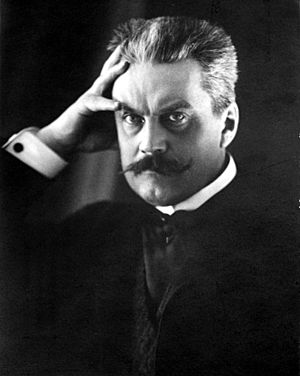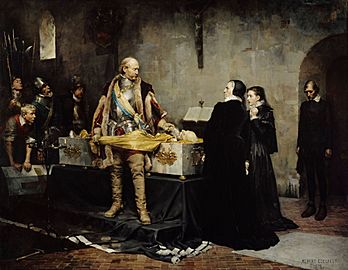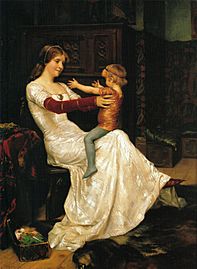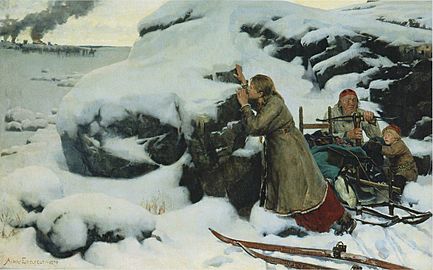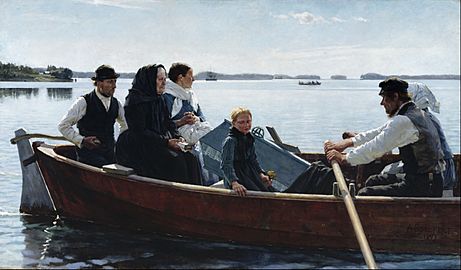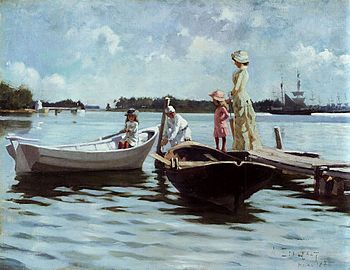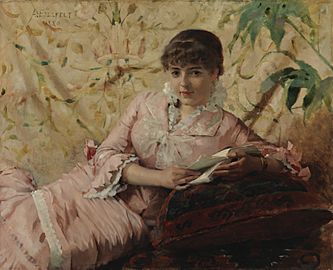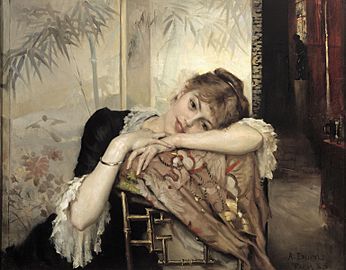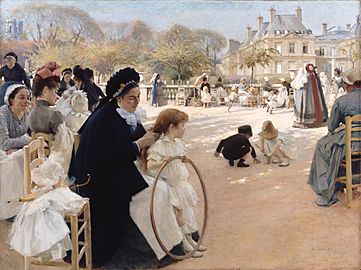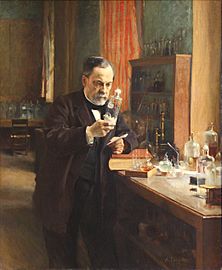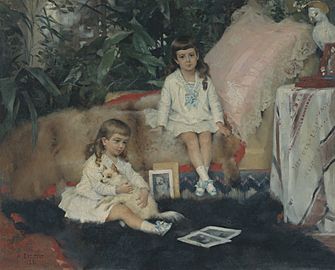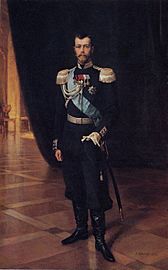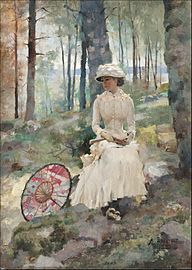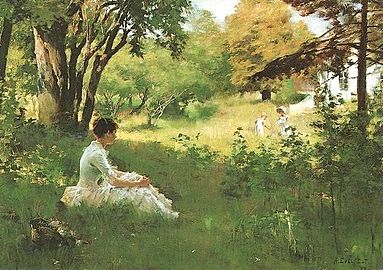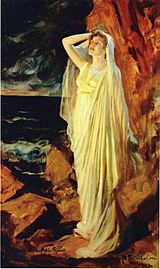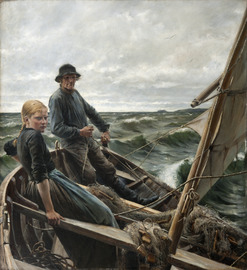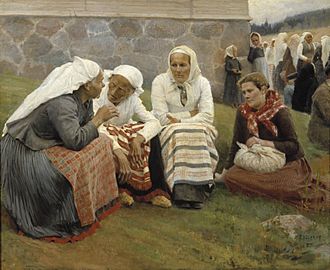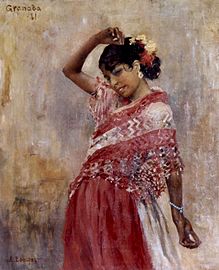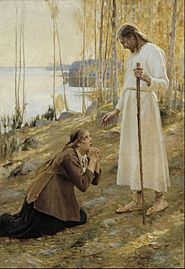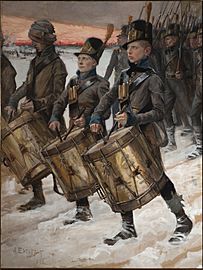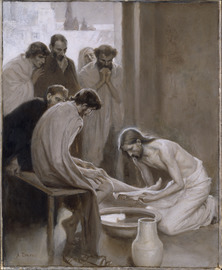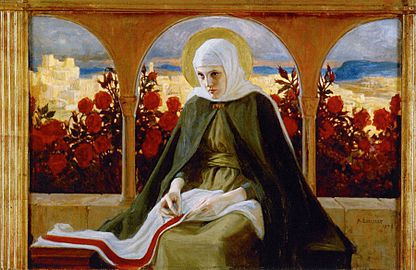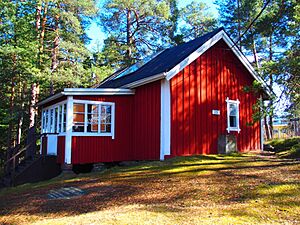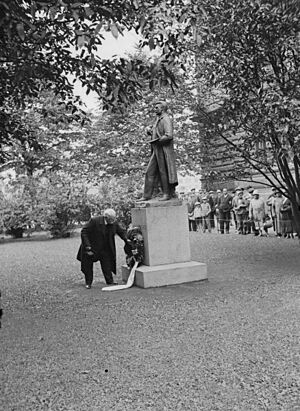Albert Edelfelt facts for kids
Quick facts for kids
Albert Edelfelt
|
|
|---|---|
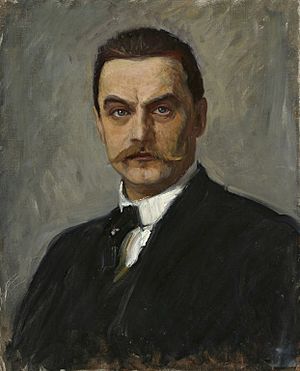
Self-portrait, c. 1887–1890
|
|
| Born |
Albert Gustaf Aristides Edelfelt
21 July 1854 |
| Died | 18 August 1905 (aged 51) Porvoo, Grand Duchy of Finland
|
| Nationality | Finnish |
| Education | Member Academy of Arts (1881) Full Member Academy of Arts (1895) |
| Alma mater | École Nationale des Beaux-Arts |
| Known for | Painting |
| Movement | Realism |
| Spouse(s) | Baroness Ellan de la Chapelle |
Albert Edelfelt (born July 21, 1854 – died August 18, 1905) was a famous Finnish painter. He was known for his realistic style of art. Albert Edelfelt lived in the Grand Duchy of Finland, which was part of Russia at the time. He helped show Finnish culture to the world before Finland became fully independent. Many people consider him one of the most important Finnish artists from the late 1800s and early 1900s. He was a key part of what is called the Golden Age of Finnish Art.
Contents
Biography
Early Life and Art School
Albert Edelfelt was born in 1854 in Porvoo, Finland. His father, Carl Albert Edelfelt, was a Swedish architect who lived in Finland. His mother was Alexandra Edelfelt. Albert's father passed away when Albert was young. This meant his mother had to raise him and his younger siblings by herself, which was financially difficult. Albert was very close to his mother throughout his life.
He started studying art formally in 1869. He went to the Drawing School of the Finnish Art Society in Helsinki. Later, he studied with Adolf von Becker from 1871 to 1873. The Finnish government gave him a scholarship to study history painting. He went to the Royal Academy of Fine Arts in Antwerp, Belgium. He studied there for several months in 1873-74. He even won an award for his painting of Alexander the Great. During this time, he also became good friends with the Belgian artist Émile Claus.
Moving to Paris and History Painting
In the autumn of 1874, when he was 19, Albert moved to Paris. His teacher, Adolf von Becker, had advised him to go. He joined the Ecole des Beaux-Arts, a famous art school. He shared a small art studio with a Finnish friend. There, he continued to focus on history painting. These were paintings that showed important moments from history. He often painted scenes from wars involving the Russians, Swedes, and Finns.
After a year in Paris, he went back to Helsinki. But he returned to Paris in 1876. He became friends with the painter Jules Bastien-Lepage. Jules taught him how to paint outdoors, which was a new and popular style.
-
Blanche of Namur, Queen of Sweden, and Prince Haquin (1877)
In 1879, he had his first big success at the Paris Salon. This was a very important art show. His painting was called The Burnt Village. French art critics liked how realistic the people in his painting looked. However, Edelfelt felt that historical scenes didn't look as real as things he had seen himself. Because of this, he mostly stopped painting historical subjects. Instead, he focused on painting outdoors.
He returned to Finland for a while. Then, in 1881, he came back to Paris and got a new studio.
Impressionism and Outdoor Painting
In the early 1880s, Edelfelt started using ideas from a new art style called Impressionism. This style focused on:
- Natural settings like parks, gardens, and the seashore.
- Cozy indoor scenes.
- How light played on people and objects.
- Painting quickly to capture the feeling of a moment.
However, he never became a full Impressionist. He still kept his realistic training. He paid close attention to small details and used many different colors.
Throughout the 1880s, Edelfelt kept painting outdoor scenes of life in Paris. He was very good at showing how light looked. He also kept his precise details. During this time, he also painted many cozy indoor scenes. These showed the everyday life in Paris.
Painting Louis Pasteur
In 1880, Edelfelt became friends with Jean-Baptiste Pasteur. He was the son of the famous scientist Louis Pasteur. Jean-Baptiste introduced Albert to his father the next year. Albert became a close friend of the Pasteur family. He painted many portraits of them over the years. Louis Pasteur was good at public relations. He even helped Edelfelt plan his own portrait.
Edelfelt's painting of Pasteur in his laboratory was made in 1885. It was a huge success at the Paris Salon in 1886. It became one of the most famous images of the scientist. This painting earned Edelfelt the Legion of Honor award. He was only 35 years old at the time.
Painting for Russian Royalty
Edelfelt started by painting portraits of his own family. But his talent quickly brought him many clients. In 1881, he visited Saint Petersburg, Russia. The Russian Academy had given him an honorary membership in 1878. The Grand Duke Vladimir Alexandrovich, who was the brother of the Russian Emperor, asked him to paint his children. This led to another request to paint the children of Czar Alexander III of Russia. In 1896, he went back to Russia to paint a portrait of Czar Nicholas II.
In 1899, Czar Nicholas II made a rule that limited the freedoms of the Finnish people. Edelfelt gathered Finnish artists and cultural leaders. They sent a petition to the Russian government called "Pro Finlandia." It asked for Finland's art to be recognized as independent. Edelfelt also helped organize Finland's participation in the Paris Exposition Universelle (1900), a big world fair.
-
Children of Emperor Alexander III of Russia (1882)
-
Portrait of Czar Nicholas II (1896)
The Finnish Countryside
Edelfelt spent his summers in Finland. He explored and painted the beautiful scenery. While his French paintings were mostly of Paris, his Finnish paintings showed the landscapes, people, and special light of the Finnish countryside. He often showed these paintings at the Paris Salon. For his painting of an outdoor church service in Haikko, near Porvoo, he made many oil sketches. He wanted to perfectly capture the colors of the water and sky.
In 1880, his family bought a summer house in Haikko, a coastal area. He set up an art studio there in 1883. He often used his family and local people as models for his paintings. His pictures look natural and spontaneous. This is because he carefully observed and understood his subjects.
Portrait Painting
Early in his career, Edelfelt became a master at painting portraits. This was how he earned most of his money. He once wrote, "Portraits for the soup, paintings for the glory." This meant portraits paid the bills, while other paintings brought him fame. From 1880 onwards, he showed his portraits at the Paris Salon.
Each portrait he painted took a long time. He would first make many drawings with pencil and crayon. Then he would use pastel colors. Finally, he would create the oil painting. He paid close attention to the person's expression and pose. He also carefully included objects around the person, like books or pets. These objects helped show the person's personality.
He painted portraits of important and famous people, like Louis Pasteur. But many of his best portraits show Finnish men and women in natural settings. These include scenes from village life or at sea.
Other Art Interests
In 1881, Edelfelt spent five weeks in Spain. There, he learned about Spanish art and culture. He was very interested in Gypsy culture and Orientalism. His most important painting from Granada is Gitana Dancing I. It shows a dancing Gypsy girl.
In the 1890s, he became interested in illustrating poetry. Edelfelt admired the poet Johan Ludvig Runeberg, who was a family friend. Runeberg's company greatly influenced Edelfelt. He sometimes painted scenes from Finnish history. Edelfelt also illustrated Runeberg's long poem, The Tales of Ensign Stål.
Edelfelt also tried religious painting later in his career. In his 1890 painting Christ and Mary Magdalene, he placed a Bible scene in a Finnish landscape. This was influenced by Finnish folk poetry called Kanteletar.
Personal Life
Albert Edelfelt sent hundreds of letters to his mother when he was away. In Paris, he shared a studio with American artist Julian Alden Weir. Julian introduced him to John Singer Sargent, another famous painter.
Edelfelt married Baroness Anna Elise "Ellan" de la Chapelle in 1888. They had known each other since they were children. In the same year, they had one child, a son named Erik. The death of his mother in 1901 affected him very much.
Albert Edelfelt died suddenly from heart failure in 1905. He was 51 years old. Many important Finnish people attended his funeral. His son Erik passed away a few years later in 1910.
Legacy
In 2013, Edelfelt's painting Boys Playing on the Shore (1884) was chosen as Finland's most important painting.
In Finland, he was one of the founders of the Realist art movement. He influenced many younger Finnish painters. He also helped other Finnish artists, like Akseli Gallen-Kallela and Gunnar Berndtson, become successful in Paris. One of his students was Léon Bakst. Edelfelt was one of the first Finnish artists to become famous around the world. He is considered one of the most important artists of the Golden Age of Finnish Art. There is a museum named after him in Porvoo. In 2004, a special €100 coin was made to celebrate 150 years since his birth. It was called the Albert Edelfelt and painting commemorative coin. The coin shows his face on one side.
See also
 In Spanish: Albert Edelfelt para niños
In Spanish: Albert Edelfelt para niños
- Golden Age of Finnish Art
- Art in Finland


